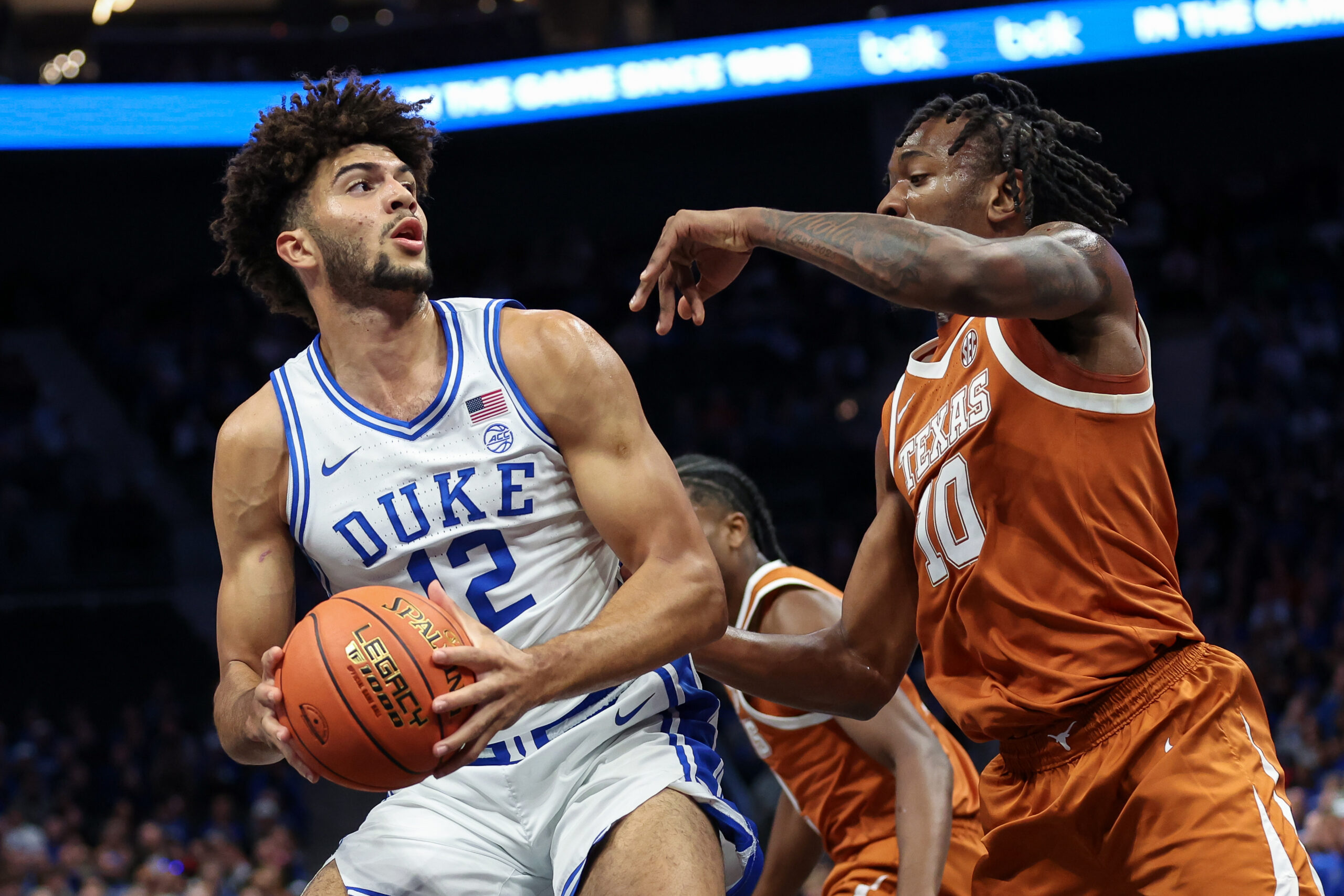Duke’s Dominance Over Texas Exposes Longhorns’ Fatal Flaws and Raises Questions About Their Future in College Basketball
The recent matchup between the No. 6 Duke Blue Devils and the Texas Longhorns has ignited a firestorm of debate regarding the future of college basketball, particularly in the context of the evolving landscape of talent and coaching. The Blue Devils secured a 75-60 victory in their season opener, showcasing the undeniable prowess of freshman sensation Cameron Boozer, who is projected to be a top-five pick in the 2026 NBA Draft. This game not only highlighted Duke’s strength but also exposed the vulnerabilities of a Texas team under new head coach Sean Miller.
In the first half, Texas managed to take a one-point lead into halftime, successfully neutralizing Boozer’s impact by holding him scoreless. This defensive effort was commendable, as it demonstrated the Longhorns’ ability to execute a game plan effectively. However, the second half told a different story. Duke adjusted, and Boozer erupted for 15 points, all scored after the break, while also contributing 10 rebounds and two assists. This shift in momentum raised questions about Texas’s defensive strategies and their ability to adapt under pressure.
Duke’s offensive execution was a testament to their coaching and player development. The Blue Devils displayed a well-honed system that allowed them to create quality shots, particularly in the second half. The transition from a stagnant first half to a dynamic second half was marked by Boozer’s aggressive play, which drew fouls and led to a significant number of free throws. Duke capitalized on this, scoring 18 of their 43 second-half points from the charity stripe. This reliance on free throws not only reflects Duke’s ability to draw fouls but also highlights Texas’s struggles in maintaining defensive discipline.
Texas’s defensive lapses were evident, particularly in their communication regarding switches on screens. The Longhorns allowed Duke to go on decisive runs, including a 12-2 surge in the first half and a 10-0 run to start the second half. These moments were critical, as they shifted the game’s momentum and put Texas on the back foot. The inability to defend without fouling ultimately undermined their first-half efforts, revealing a lack of cohesion that could be detrimental as the season progresses.
Offensively, Texas showed flashes of improvement in ball movement and player execution, but they struggled to translate this into consistent scoring. The Longhorns managed only six fast-break points, a stark contrast to Duke’s ability to capitalize on transition opportunities. This deficiency can be attributed to a combination of factors, including a lack of defensive stops and the inability to create turnovers. The statistics tell a troubling story: six assists on 19 made baskets is indicative of an offense that is still finding its rhythm.
Individual performances also played a significant role in the outcome. Junior forward Dailyn Swain led Texas with 16 points but faded after a strong start, going 3-of-12 shooting for the remainder of the game. The supporting cast, including graduate wing Tramon Mark and senior guard Chendall Weaver, combined for a mere five points, raising concerns about the depth and reliability of the Longhorns’ roster. The bench contributions were equally disappointing, with junior forward Cam Heide failing to attempt a shot and junior guard Simeon Wilcher scoring zero points in 15 minutes of play.
The struggles of key players such as graduate forward Lassina Traore and sophomore center Matas Vokietaitis further compounded Texas’s issues. Traore’s four turnovers and four fouls nearly matched his five points, while Vokietaitis’s performance was a mixed bag—he scored 15 points but also committed multiple turnovers. This inconsistency from the team’s bigs is troubling, especially as they look to establish a dominant presence in the paint.
The broader implications of this game extend beyond just one loss. Texas’s performance raises critical questions about their trajectory under Miller’s leadership. The Longhorns are expected to face less formidable opponents in the coming weeks, which could provide an opportunity for growth and development. However, the challenges presented by Duke serve as a stark reminder of the level of competition they will face throughout the season.
As the Longhorns prepare for their home debut against Lafayette, the focus will be on improving their offensive efficiency and defensive communication. The upcoming games will be crucial for establishing momentum and building confidence as they head into a challenging schedule, including a trip to Maui for a prestigious tournament. The ability to learn from this defeat and adapt will be essential for Texas if they hope to compete at a high level in the ever-evolving landscape of college basketball.
In contrast, Duke’s victory solidifies their status as a powerhouse in the early season rankings. The Blue Devils’ blend of talent, coaching, and execution positions them as a formidable contender for the national championship. The question remains whether there are five teams better than Duke to start the season, and if they can maintain this level of play as the season unfolds. The stakes are high, and the pressure is on both programs to deliver results that align with their aspirations.

In a one-and-done college career that will most certainly culminate in a top-five selection in the 2026 NBA Draft, Cameron Boozer projects to this level this season as an inevitable and irresistible force operating within a well-honed Durham machine.
The Texas Longhorns felt that inevitability in the second half of the season opener against the No. 6 Duke Blue Devils in Charlotte on Tuesday, a 75-60 victory at the Spectrum Center keyed by Boozer scoring all 15 of his points in the second half while adding 10 rebounds and two assists in the final 20 minutes.
In head coach Sean Miller’s debut, Texas took a one-point lead into halftime by holding Boozer scoreless thanks to seven missed shot attempts and zero offensive rebounds, an impressive collective team effort for the Longhorns that also succeeded in harassing the Blue Devils into poor shooting stretches early and late in the first half.
In between, nine straight shots made by Blue Devils other than Boozer in a key first-half run came from some efficient offensive execution that produced four good looks from three converted by sophomore guard Isaiah Evans and quality shots at the rim operating out of crisp five-out looks engineered by Scheyer.
Then, out of the halftime break, Scheyer set up his freshman superstar to attack downhill and Boozer took advantage by producing a 9-of-11 performance from the free-throw line in the second half as Duke got into the bonus at the under-12 timeout.
The Horns ultimately committed 15 fouls in the second half, leading to 22 free throws by the Blue Devils — of the 43 points scored by Duke after halftime, 18 came at the line. The inability to defend the Blue Devils in the second half without fouling spoiled a good effort defensively considering the stress that Duke put on Texas defenders with its five-out attack.
In too many moments, though, the Longhorns weren’t crisp enough with their communication about switches on screens and gave up quality looks or committed fouls that led to the Blue Devils making the game’s decisive surges — a 12-2 run in the first half and a 10-0 run to open the second half.
Offensively, Texas showed signs of improved ball and player movement in halfcourt sets, but weren’t able to get out in transition with any pace to create easy baskets, scoring just six fast-break points, partly because the Horns only blocked two shots and made four steals.
Junior forward Dailyn Swain scored a team-high 16 points in his Texas debut, starting with 4-of-6 shooting stretch during the game’s first 7:50, including his 12th and 13th career made threes, before going 3-of-12 the rest of the way.
Starting next to Swain, graduate wing Tramon Mark and senior guard Chendall Weaver combined for five points as Weaver only played 15 minutes, scoring three points in a 1-of-5 shooting performance that left him minus-11 on the court. Playing his 137th college game, Mark recorded 24 minutes with 1-of-2 shooting, one assist, two turnovers, and two personal fouls in a minus-10 performance.
Off the bench, junior forward Cam Heide didn’t attempt a shot in nine minutes despite Texas needing some three-point shooting volume from the Purdue transfer, and junior guard Simeon Wilcher added zero points in 15 minutes, missing his three shot attempts while committing a turnover and finishing minus-11. At least Wilcher had two of the team’s six assists?
Six assists on 19 made baskets is an ugly start to the season for Texas offensively with two starters and two key bench players providing five total points and the team’s most important bigs, graduate forward Lassina Traore and sophomore center Matas Vokietaitis, struggling with turnovers.
Traore’s four turnovers and four fouls nearly matched his five points while Vokietaitis committed two fouls on offense in addition to his other three turnovers, but the 7’0-foot Lithuanian did at least get to the line for 10 free throws, hitting nine and scoring 15 points in his Texas debut. Call it boom or bust for the Florida Atlantic transfer, who notably missed a dunk on a lob from Swain to open the second half on a nice called play by Miller and his staff and worked hard around the rim on the frequent Texas misses, including his own, but didn’t get enough out of those efforts.
Coming off the bench and scoring 15 points, Pope managed a typically empty-caloric performance, scoring 10 of his points while finishing minus-seven in his 16 second-half minutes as Weaver only saw three minutes of game time. Two fouls and difficulty navigating screens contributed to points for Duke offensively and illustrate the continued issues Pope has on that end — it’s fouls or busted coverages.
Overall effort and some level of execution on both ends allowed Texas to outscore Duke in the first half and battle at times after halftime with those flashes of better ball and player movement offensively. To the credit of the Blue Devils, Scheyer’s team made it difficult for the Horns to regularly produce easy looks in transition or in halfcourt offense because Duke is already a sound defensive team in its season opener.
Are there really five better teams than the Blue Devils to star the season? Will there be that many teams better than Duke at the end of the season?
The expectations are much more modest for Miller’s team at the moment, and understandably so.
Given the competition level, the Longhorns operated with a better pace of ball and player movement than last season that should pay increasing dividends against decreasing competition because of increased practice time with Traore and Vokeitaitis after their preseason injuries took away so many key practice and scrimmage reps.
Texas makes its home debut against Bart Torvik’s preseason No. 277 team, Lafayette, at the Moody Center on Saturday at 2 p.m. Central, the first of four buy games in Austin before the Horns head to Maui over Thanksgiving in three weeks.

